February 7th, 2013 at 9:46 pm (Animals, Biology)
I killed two ants the other day, for Science. “Adventures with a Microscope” instructs you in how to kill a fly so that you can remove its legs and eyes for a close look under the microscope. No flies were available, so I victimized some ants who kept trying, with mindless persistence, to invade my personal space. I put them under glass, where one asphyxiated, slowly, as I had no chloroform. The other escaped and I flicked it into some water, where it drowned. I felt more than a few twinges of guilt, staring at their huddled corpses, but then decided to examine them under the microscope.
And oh, how glorious!
40x (lowest magnification):
The segmented, slightly blurry object on the right is its antenna.
The thin filament is (I think) carpet fuzz.

Note the difference in texture between chitin and eye (zoom 100x):
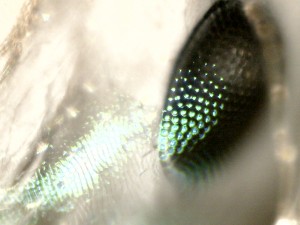
Zoom 200x:

These were all taken with reflected light, since ants don’t transmit light well. But are they not beautiful and alien, seen up so close? We’ve all heard of the fly’s multi-faceted eye. I’m not sure I realized that the ant’s is likewise complex and compound.
Wow.
7 Comments
4 of 5 people learned something from this entry.
February 2nd, 2013 at 10:36 pm (Exercise, Health, History)
 While scanning old newspapers for the library, I came across this Monrovia Daily News article from August 23, 1915. The University of California announced its standards for its incoming freshmen in terms of their physical fitness and abilities. But it’s more than being fit — the word “moral” appears throughout the article, and it is emphasized as if obvious that being physically fit leads to moral fiber as well. Wow!
While scanning old newspapers for the library, I came across this Monrovia Daily News article from August 23, 1915. The University of California announced its standards for its incoming freshmen in terms of their physical fitness and abilities. But it’s more than being fit — the word “moral” appears throughout the article, and it is emphasized as if obvious that being physically fit leads to moral fiber as well. Wow!
At any rate, I was amused to discover that the *only* items on the list that I would be able to perform are two of the swimming ones: to swim 50 yards (note there is no time limit specified) and to dive from a height of five feet. The others are well beyond my physical ability.
On the other hand, if they had been imposed as requirements at some point, maybe I would have worked to achieve them!
So, do you measure up? Can you imagine if this were required of freshmen today?
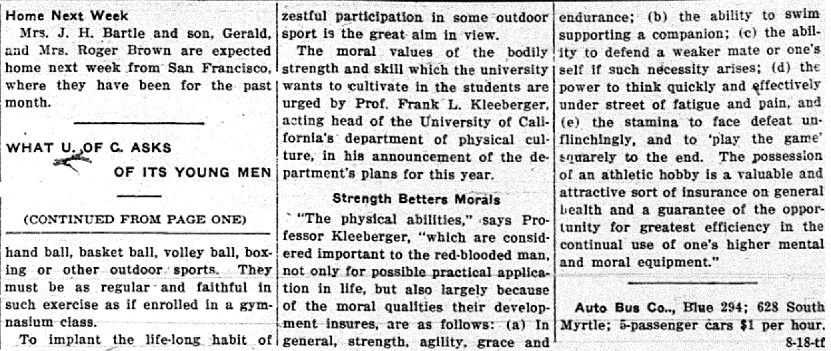
2 Comments
2 of 2 people learned something from this entry.
January 29th, 2013 at 8:57 pm (Books, History, Library School)
 My class on the History of Books and Libraries started off with a tour of ancient writing systems and libraries. We covered a wealth of fascinating content. For example, it had never occurred to me that the Lascaux cave paintings were three-dimensional, since they were painted onto irregular cave walls! I’d only ever seen flat-looking 2D pictures like the one at right. Today you can visit the Lascaux cave paintings in 3D through the magic of the Internet. Do it! I sat there enthralled as I floated through the twisty little passages and came away with an entirely different sense of this early artwork. “Early” is an understatement. The paintings are estimated to be 17,000 years old!
My class on the History of Books and Libraries started off with a tour of ancient writing systems and libraries. We covered a wealth of fascinating content. For example, it had never occurred to me that the Lascaux cave paintings were three-dimensional, since they were painted onto irregular cave walls! I’d only ever seen flat-looking 2D pictures like the one at right. Today you can visit the Lascaux cave paintings in 3D through the magic of the Internet. Do it! I sat there enthralled as I floated through the twisty little passages and came away with an entirely different sense of this early artwork. “Early” is an understatement. The paintings are estimated to be 17,000 years old!
I also learned that cuneiform tables had a 3D aspect not only in their wedge-shaped impressions but because, as chunks of clay, they were rather thick, and scribes took advantage of this to write on all sides, including the edges. Browse all sides of real tablets yourself! (Now I want to make my own, maybe out of Play-doh.)
 We discussed various writing systems, and you can browse several historical scripts as well as (quite curiously) constructed scripts, mainly for English, that replace our current alphabet. One of my favorites is Heptal (rendered at right). We also discussed boustrophedon, a word I will never again misspell.
We discussed various writing systems, and you can browse several historical scripts as well as (quite curiously) constructed scripts, mainly for English, that replace our current alphabet. One of my favorites is Heptal (rendered at right). We also discussed boustrophedon, a word I will never again misspell.
Finally, we covered the ancient libraries at Nippur, Ur, Nineveh, and Alexandria. The library at Nineveh was the creation of Ashurbanipal and grew to contain 30,000 clay tablets, with a complex indexing system and integrated book curses. My assignment for this week was to create a “learning activity” about Ashurbanipal and his library.
Dare you take my quiz? Will you earn yourself Ashurbanipal’s admiration or his scorn?
1 Comments
1 of 1 people learned something from this entry.
January 22nd, 2013 at 11:33 pm (Biology, Chemistry)
Adventure 2 in “Adventures with a Microscope” is titled “We Become Crystal Gazers.” The author continues:
We are not going to peer into such crystals as fortune tellers use, in which they claim to be able to predict that some rich relative is going to leave you money, or some equally nonsensical bosh.
No indeed, this is about chemistry. So I followed along, heated some water, and mixed up supersaturated solutions of various interesting substances from my kitchen. And wow, check it out! (Click to enlarge.)
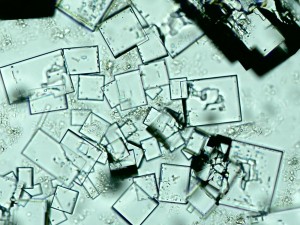
Salt. Best viewed ~1 hour after deposition on the slide, with partial crystal formation; if you wait longer, the slide becomes crowded, and since the crystals are cubes, it’s hard to get them all in focus (too much relief!). I love this shot. It reminds me of Flatland.
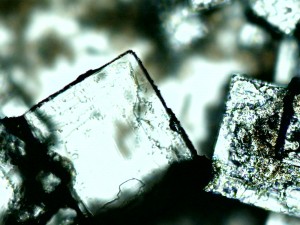
More salt, the next day, with larger crystals.
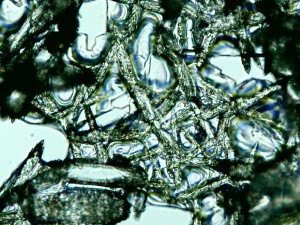
Baking soda, which apparently creates sparry crystals.
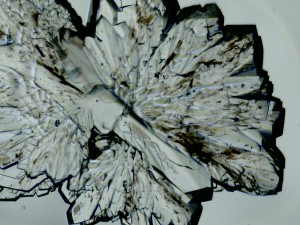
Sugar! This one took a full day to form interesting crystals. But wow, they are gorgeous!
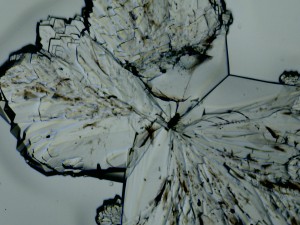
More sugar, almost a butterfly-like configuration. I expect the symmetry is coincidence.

The biggest surprise for me — my saliva, 24 hours later, had created these awesome fractal patterns. At first I thought it might be nucleation following tiny scratches in the slide glass, but the fact that they’re fractal renders this unlikely. No clue what this is, but my best guess is that it’s just random diffusion patterns, like these manganese fractal patterns.
Aha, I found an article titled “Dendritic growth in viscous solutions containing organic molecules” which has these great examples:

Caption: “Crystal patterns of some body fluids: (a) saliva; (b) cerebrospinal fluid; (c) urine; (d) blood serum.”
My examples seem to match the “blood serum” image the best, but I assure you it was saliva. Not sure what’s going on in their sample (a)!
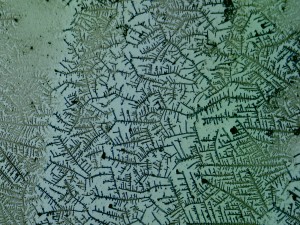
The more I panned across the expanse of fractal growth, the more it started looking like a map of a European city. Is it not marvelous?
5 Comments
5 of 5 people learned something from this entry.
January 18th, 2013 at 9:39 pm (Biology, Plants)
The world just expanded by a factor of ten. At least.
Of course this is true in a literal sense, given the arrival of my Celestron 44345 microscope. I can now see down to scales previously invisible to my eye, magnifying at 40x, 100x, 200x, 1600x! But even more meaningful is the figurative way in which things have expanded. I have access to a rich, teeming layer of reality that previously existed only in a hypothetical fashion. And because this is a microscope with a digital camera embedded in it, I can also store and share what I see.
I first took a look at the seven prepared slides that came with the microscope. Here are some examples of the fantastic sights I saw (click to zoom):
Pine:
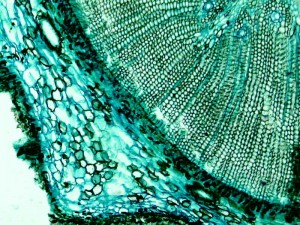 Epithelium:
Epithelium:
 “Apple” (seed? cell? blossom? wha?):
“Apple” (seed? cell? blossom? wha?):
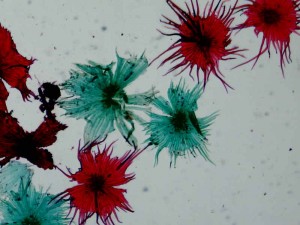
I’ve now placed an order for a set of blanks so that I can prepare my own slides to study anything I encounter — and even just within the confines of my house there is a veritable zoo of things to study. High on my list is sampling from the cornucopia of interesting structures that grow in my compost bin. I can’t wait to share what I discover!
3 Comments
1 of 2 people learned something from this entry.





 My class on the History of Books and Libraries started off with a tour of ancient writing systems and libraries. We covered a wealth of fascinating content. For example, it had never occurred to me that the Lascaux cave paintings were three-dimensional, since they were painted onto irregular cave walls! I’d only ever seen flat-looking 2D pictures like the one at right. Today you can
My class on the History of Books and Libraries started off with a tour of ancient writing systems and libraries. We covered a wealth of fascinating content. For example, it had never occurred to me that the Lascaux cave paintings were three-dimensional, since they were painted onto irregular cave walls! I’d only ever seen flat-looking 2D pictures like the one at right. Today you can  We discussed various writing systems, and you can
We discussed various writing systems, and you can 









